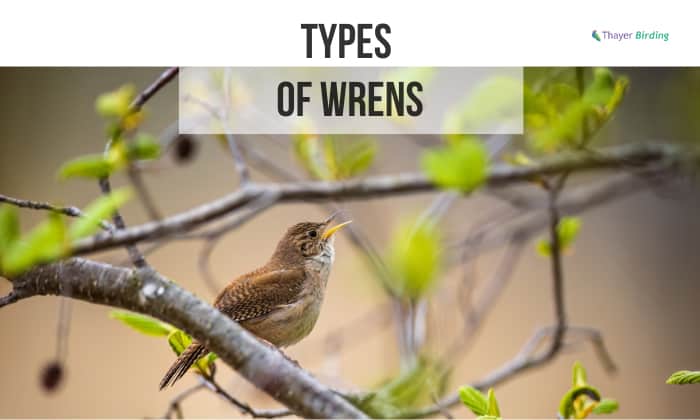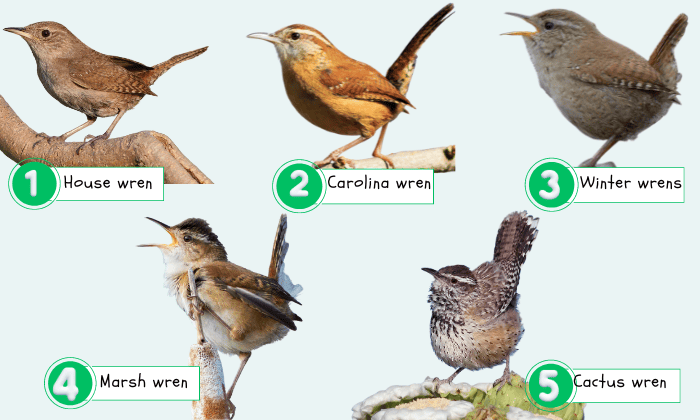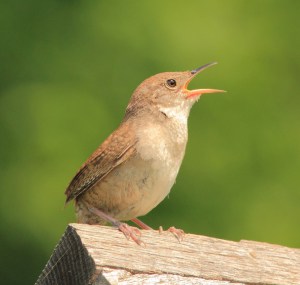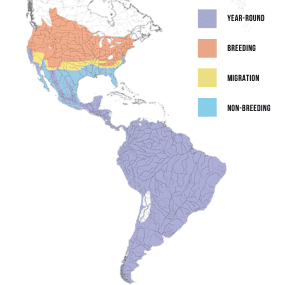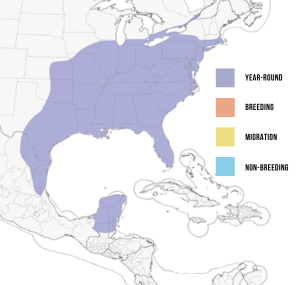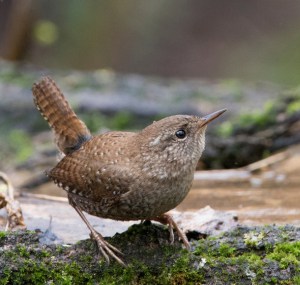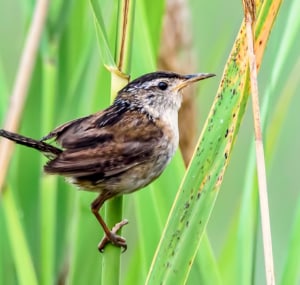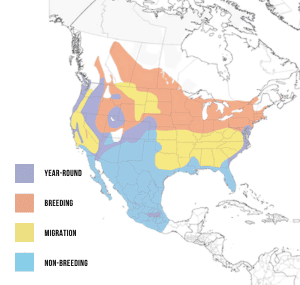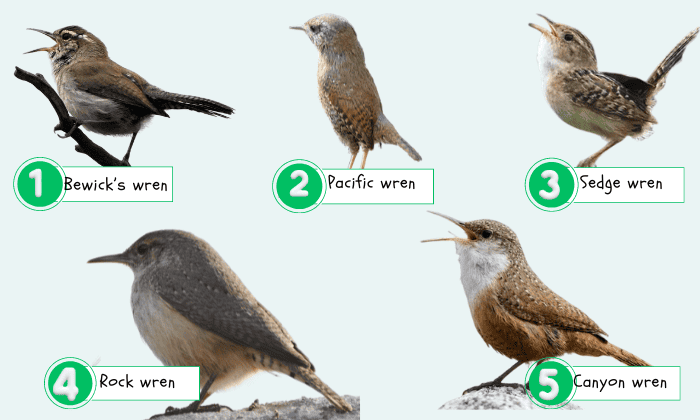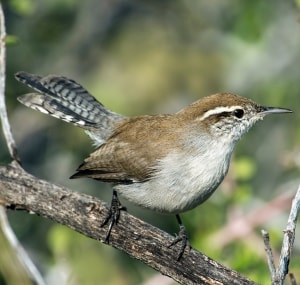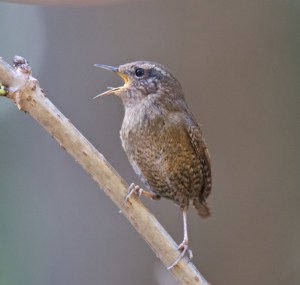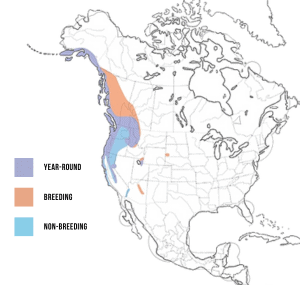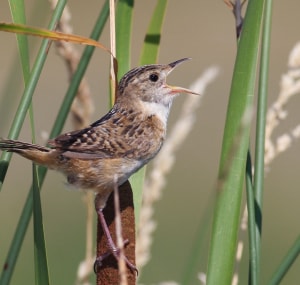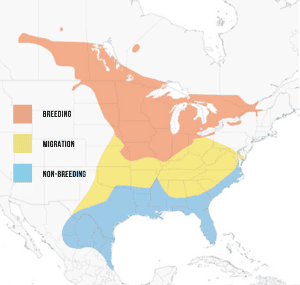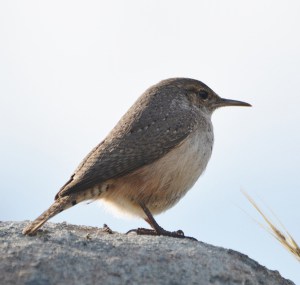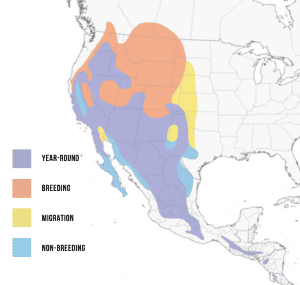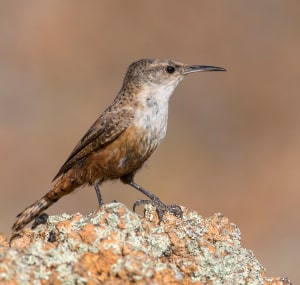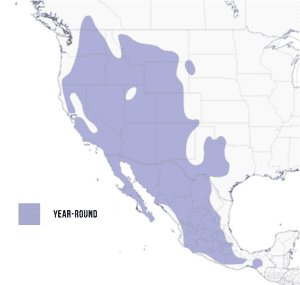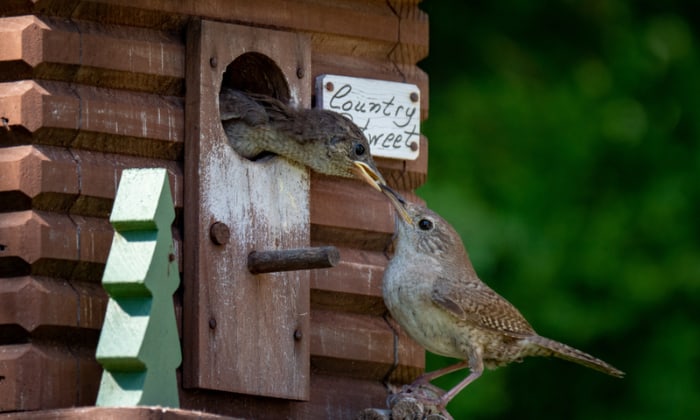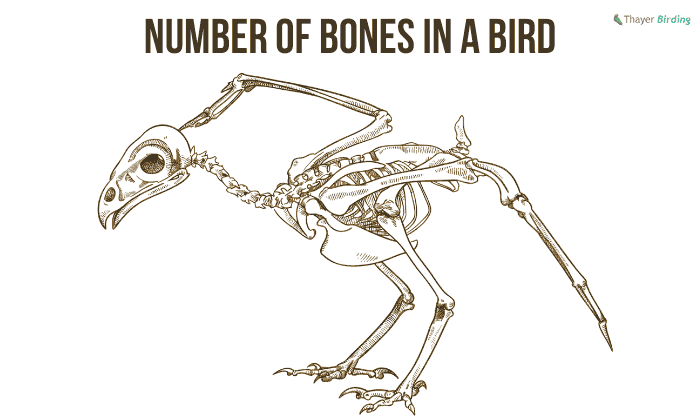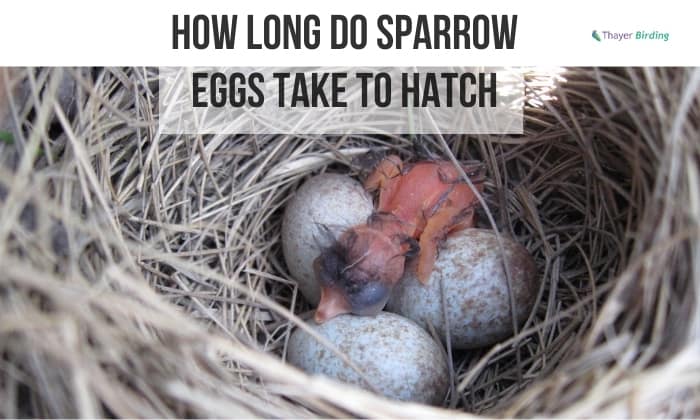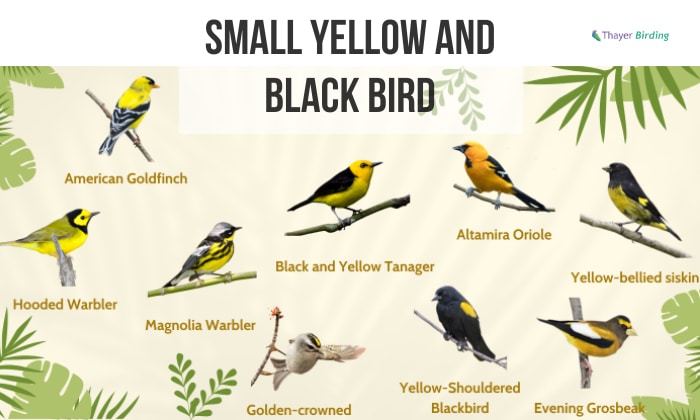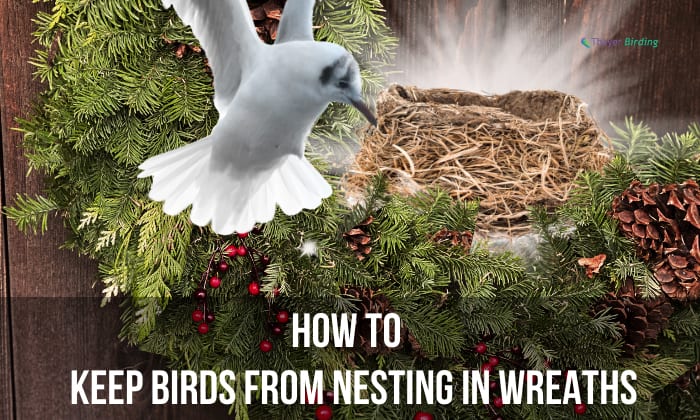Though House wrens are more populous than Carolina wrens in North America, they are a migrating species only seen in summer. The species more consistently seen year-round is the Carolina wren!
However, North America actually has 11 types of wrens, with the ten most popular being the House, Carolina, Winter, Marsh, Cactus, Bewick’s, Pacific, Sedge, Rock, and Canyon.
Read on to see images of wrens and learn all about wren identification!
Major Wren Species
According to population size, these five wren species are the most prevalent in the Americas.
House wrens are small birds, usually with a wren size of 4-5 inches long and a 6-inch wingspan. There are 32 recognized subspecies of this bird that come in shades of brown, gray, and white.
However, all house wrens sport pink or gray legs, faint eye-rings, and long, thin bills.
- Habitat and Range
The house wren is the most common type in the Americas, found in Canada to the tip of South America. How many wrens are there? Scientists estimate their population size to be 160 million!
These birds live in open woods, thickets, and the gardens of suburban areas. They take shelter in dense thickets or streamside brushes during winter for protection and warmth.
- Behavior and Vocalizations
House wrens are active and curious, constantly bouncing around with their short tail held upward. They are also known for their cheerful song during the nesting season.
- Nesting Habits
All wrens nest in pre-existing cavities such as tree hollows, old woodpecker holes, nest boxes, or building crevices.
Males go around building numerous half-finished nests. When the female makes her pick, she finishes the nest with a lining such as feather and snakeskin.
Females lay between 5-8 spotted white eggs per clutch. They typically have two broods per year and only sometimes have three.
Carolina wrens are known for being one of the most colorful in their family, being a brownish, red wren species.
- Habitat and Range
Carolina wrens are very common along the eastern side of North America. Experts estimate this wren makes up 17% of the North American wren population!
Like house wrens, these birds are comfortable in suburban areas. They are also found in mixed woods and thickets along forest edges.
- Behavior and Vocalizations
These tiny birds constantly explore their surroundings to forage for food such as beetles, crickets, and spiders.
They live in pairs year-round and have a unique duet of female wren bird chattering and male wren bird singing. Otherwise, each bird can also be heard happily chirping away.
- Nesting Habits
Carolina wrens may mate for life, though they may also change partners. However, male and female Caroline wrens always have a mate, regardless of the season.
Like all wrens, they build their nests inside cavities. Their nests are twigs, leaves, and weeds lined with soft grass, moss, hair, and feathers.
Females lay 4-8 eggs in a clutch with 2-3 broods yearly. Their wren eggs are white with brown spots and take two weeks to hatch.
What does a wren look like? Winter wrens are small, brown, and stout, comparable to most other species of their family. They have dark bars on their belly, wings, and tail and a pale stripe across the bridge of their nose.
- Habitat and Range
Winter wrens have a total estimated population size of 11 million birds. They are typically found in woodland underbrush and, in the summer, in conifer forests.
During winter, they are found across the eastern United States. As the hot season approaches, they spread upward, reaching the northeastern United States and Canada.
- Behavior and Vocalizations
Bird enthusiasts have described winter wrens as “secretive” birds, often seen sneaking around on the ground under cover of dense foliage. However, males fly to high branches in the spring to show off their trilling song.
- Nesting Habits
To win over females, males land near them and perform an elaborate number with fluttering, half-open wings and wagging tails while singing.
Winter wrens typically have 5-6 eggs in a brood, though the number can fall between 4-7. Both parents stay to feed the young until they fly off 19 days after hatching.
Marsh wrens have medium to dark brown coats with bars on their tail and wings. They also have a small line down their back and a clearly defined eyebrow mark.
- Habitat and Range
Marsh wrens have an estimated population size of 11 million. As their name suggests, they can be found in marshes and wetlands across North America with plenty of reeds and cattails.
- Behavior and Vocalizations
These birds are small but fierce. Males are highly territorial and will even aggressively destroy nests of rivals or pierce their eggs.
When they aren’t fighting, these birds are content to jump from reed to reed, occasionally climbing to the top of the stem to look around. They have a sputtering, bubbly song that sounds like very fast trilling.
- Nesting Habits
Males defend their territories with their songs. Interestingly, scientists have noted that western marsh wrens have more songs than their eastern counterparts.
Males build several dummy nests for the female to choose from. The rest either go unused or become a sleeping place for adults in other seasons.
Females typically lay 4-5 eggs in a clutch, but the number can vary between 3-6. Their eggs are pale brown with a small opening. These birds typically have two broods in a year.
Cactus wrens build their nests in cacti. They are the largest wren in the United States, with a wingspan of 11 inches. They are also the state bird of Arizona!
They are typically brown with white streaks with a heavy bill and rounded tail. Several subspecies are spread out in the southwestern area of North America.
- Habitat and Range
Cactus wrens are found in dry brush and deserts where cacti and yucca plants thrive. However, they may also be found in low, arid habitats and the mesquite shrub.
This species has an estimated population size of 8.5 million birds.
- Behavior and Vocalizations
These wrens have a confident character and harsh rasping voices, very different from the other wrens’ more pleasant singsong voices.
They live in pairs or family groups, hopping or waddling along the ground with their wings and tails spread.
- Nesting Habits
Cactus wren mates have a greeting display where they perch upright and give a harsh call.
Their favorite cactus to build nests in is the cholla cactus, but they will also build homes in yucca trees and other thorny low plants. The nest is circular and used pretty much year-round.
Females lay 2-5 eggs in a clutch.
Lesser-known Wren Species
While these wrens aren’t particularly “lesser-known,” they are seen less often.
Bewick’s wrens (pronounced like “Buick”) are primarily brown with whitish-gray undersides and a white throat. This black and white wren also has a wingspan of around 7 inches.
- Habitat and Range
Bewick’s wrens have a small range, typically only seen in the center of the United States (Texas, New Mexico, Arizona, Oklahoma) and along the Pacific coast (California, Oregon, and Washing State). Sometimes, they can be seen in Mexico.
They have an estimated population size of 7,900,000 birds.
These birds thrive in thickets, underbrush, and gardens but can also be found in forests and near streams.
- Behavior and Vocalizations
Bewick’s wrens are active little birds, often seen climbing and hopping on trunks and branches, probing into crevices, and turning over leaves. Typically, you’ll see this bird foraging for insects.
They have a loud, trilling, two-note song.
- Nesting Habits
Bewick’s wrens build nests in cavities, from natural hollows in trees to mailboxes and tin cans, often less than twenty feet off the ground.
Females typically lay 5-7 eggs, but the number can be between 4-11. Their eggs are white with brown and gray blotches.
Pacific wrens are a brown wren with bars on their wings, belly, and tail. They were once considered the same species as Winter wrens, until 2010 when ornithologists split the species.
- Habitat and Range
There are an estimated 7.5 Million Pacific wrens. They are found in the Pacific Northwest and Alaska islands’ forests, thickets, and open habitats.
- Behavior and Vocalizations
Pacific wrens are known for quietly creeping along the ground, more easily seen than heard. They release sharp “keep keep” sounds and long tumbling staccato notes.
- Nesting Habits
This brown wren sings to defend his territory and attract mates. Aside from singing, males perform an intricate display with their wings and tails while perching.
They nest in natural cavities close to the ground, no more than six feet high. Their nests are primarily built with grass, weeds, and moss and lined with animal hair and feathers.
Females lay between 4-7 eggs, averaging 5-6. They are white with reddish-brown dots and smaller than an inch.
Sedge wrens have very short tails, shorter than even other wrens’. They are russet-brown and have a wingspan of around five inches. They also have blurry-looking stripes or spots across their backs and tails.
- Habitat and Range
Sedge wrens are found in grassy marshes and meadows. Though still with a large estimated population size of 5.4 million, scientists have noted a decline in their numbers for unknown reasons.
They are mostly seen around the Gulf Coast but also in northern states like Michigan and Wisconsin.
- Behavior and Vocalizations
Most bird watchers find it hard to keep track of Sedge wrens, as they have a tendency to move from place to place erratically.
Overall, they are shy birds who spend most of their time foraging for insects. They also love calling each other with their chirpy, trilling songs.
- Nesting Habits
Sedge wrens frequently change their nesting locations. Their nests are round balls woven from sedges and grasses with a small entrance to the side.
Females typically lay 4-8 white, unmarked eggs per brood.
Rock wrens are usually light brown with paler undersides. They have faint speckles and bars running down their tails. They also have a slender bill.
- Habitat and Range
There are an estimated 4 million rock wrens. They are found in rocky regions of the western United States and migrate south in the winter.
High or low elevations are acceptable if their habitat is open and arid. When no rocks exist, they seek refuge around hay bales, farm equipment, or other landmarks.
- Behavior and Vocalizations
Rock wrens are frequently observed bouncing on their tiny legs. They usually forage for food in rocks and vegetation.
- Nesting Habits
Rock wrens create small “porches” in front of their nest entrances that look like a paving of small pebbles. Females lay an average of 5-6 eggs, but the number varies between 4-8.
The Canyon wren is a small brown bird with long beak. They are reddish-brown, similar to Carolina wrens, and possess short, strong legs with a wingspan of up to eight inches.
- Habitat and Range
Canyon wrens live around canyons, cliffs, rocky areas, and stone buildings.
These birds live on the western side of North America, except along the Pacific coast. They have an estimated population size of one million, with more than half living in Mexico.
- Behavior and Vocalizations
Canyon wrens sing a song of descending whistle notes that slow down and eventually trail off. Males often sing longer than female birds, though both sexes can duet together.
- Nesting Habits
This bird sings a lot to announce its territory! Male canyon wrens sing to let others know that a place is taken and they are willing to defend it.
Similar to other wrens, this species nests in cavities and builds nests with plant materials and feathers.
Females typically lay five eggs but may sometimes be as few as three and as many as seven.
Frequently Asked Questions
Are wrens beneficial to the environment?
All birds, including wrens, benefit their environment and the big ecosystem picture in several ways. These include controlling insect populations and spreading mushroom spores, pollen, and plant seeds.
How can I attract wrens to my backyard?
More than food, wrens are drawn to shelter.
If you want to attract wrens to your backyard, provide many crevices where they can build their nests with stones, lawn art, or your yard trees. You can also create a brush pile for them to forage around and add plenty of vegetation to your landscape.
What bird looks like wren, but is bigger?
Sparrows! Sparrows are also small brown birds that are easily mistaken for wrens, but are slightly bigger.
While most wrens have a wingspan of only 6 inches long, sparrows can reach 7 inches or more. Sparrows also have longer bodies than wrens.
Conclusion
There are many types of wrens around the country. Some stay in one place all year, while others migrate and move around.
Wrens are typically named after their habitats, giving easy clues about where to find each species.
Whichever wren is near you, you will surely enjoy their cheerful song, whether or not you can spot the little birds. And if you are trying to coax them into your garden, we wish you the best of luck!

George and I became friends after a birdwatching trip with our new group. And we have been enjoying every adventure together. When he told me the idea of establishing a site that shares our experiences and fun, I immediately agreed. After trials and errors, here we have Thayerbirding.


